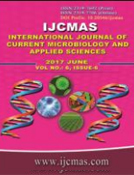


 National Academy of Agricultural Sciences (NAAS)
National Academy of Agricultural Sciences (NAAS)

|
PRINT ISSN : 2319-7692
Online ISSN : 2319-7706 Issues : 12 per year Publisher : Excellent Publishers Email : editorijcmas@gmail.com / submit@ijcmas.com Editor-in-chief: Dr.M.Prakash Index Copernicus ICV 2018: 95.39 NAAS RATING 2020: 5.38 |
A 60-day feeding trail was conducted to determine the effect of dietary zinc level and temperature on growth and antioxidant enzyme in Pangasianodon hypophthalmus. The six distinct treatment groups were fed with diets prepared with different zinc levels (16, 32 and 48 mg/kg respectively) in two temperature like 34ËšC and ambient temperature. After 60 days experimental trial, the growth parameters like percent weight gain, FCR, PER, SGR and enzymes Superoxide Dismutase–I and Catalase were studied. In T3 group inclusion level of 48 mg/kg of zinc with 34ËšC showed maximum SGR compared to other groups. The feed conversion ratios of different experimental groups were showed significant difference (p<0.05). The lowest (1.45±0.11) FCR was recorded in T3 group. The highest FCR was found in T5 (2.20±0.11) group. The highest PER value was recorded in T3 (2.32±0.04) group. The lowest PER was recorded in T5 (1.48±0.13). The value of the PER and SGR was found in same trend as specific growth and the correlation for each other. In the present study the SOD activity was significantly higher in group T3 (p<0.05) compared to the other groups in muscle. From the present work it can be said that dietary inclusion of zinc had better impact on growth at the two studied temperature, so the 48 mg/Kg zinc can be recommended for the inclusion in diet of Pangasianodon hypophthalmus at both ambient and 34ËšC temperature.
 |
 |
 |
 |
 |